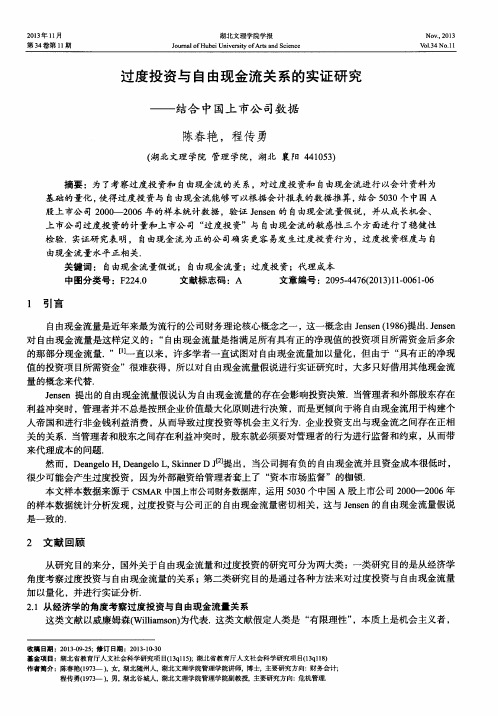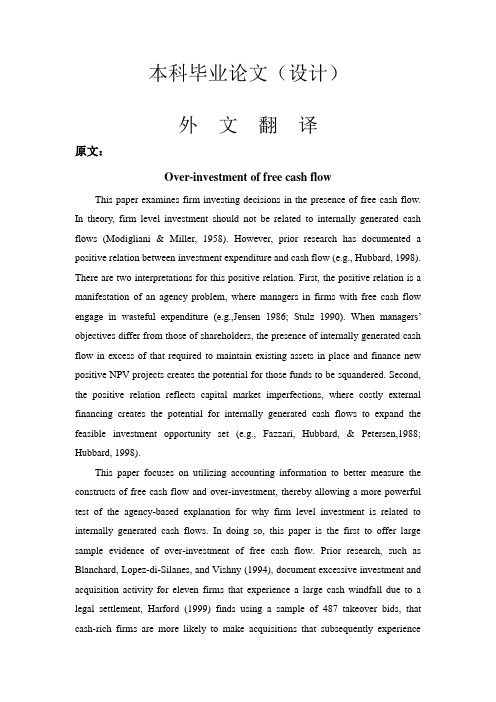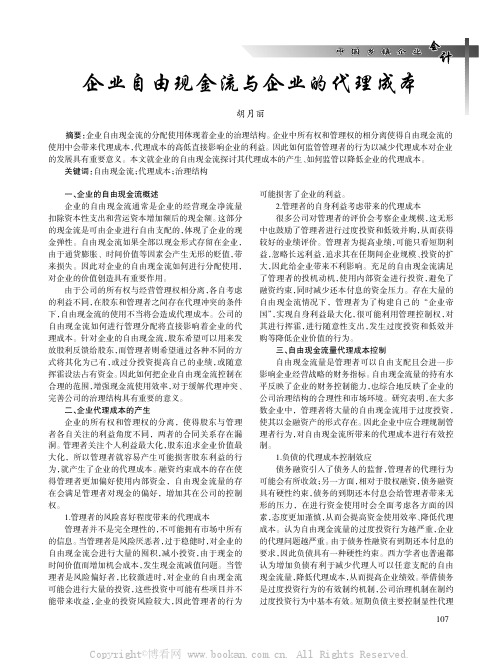钱多办_坏_事_自由现金流量与过度投资
- 格式:pdf
- 大小:156.63 KB
- 文档页数:5



自由现金流自由现金流自由现金流(Free Cash Flow)作为一种企业价值评估的新概念、理论、方法和体系,最早是由美国西北大学拉巴波特、哈佛大学詹森等学者于20世纪80年代提出的,经历20多年的发展,特别在以美国安然、世通等为代表的之前在财务报告中利润指标完美无瑕的所谓绩优公司纷纷破产后,已成为企业价值评估领域使用最广泛,理论最健全的指标,美国证监会更是要求公司年报中必须披露这一指标。
自由现金流量,就是企业产生的、在满足了再投资需要之后剩余的现金流量,这部分现金流量是在不影响公司持续发展的前提下可供分配给企业资本供应者的最大现金额。
简单地说,自由现金流量(FCF)是指企业经营活动产生的现金流量扣除资本性支出(Capital Expenditures,CE)的差额。
即:FCF=CFO-CE。
自由现金流是一种财务方法,用来衡量企业实际持有的能够回报股东的现金。
指在不危及公司生存与发展的前提下可供分配给股东(和债权人)的最大现金额。
[1]自由现金流在经营活动现金流的基础上考虑了资本型支出和股息支出。
尽管你可能会认为股息支出并不是必需的,但是这种支出是股东所期望的,而且是一现金支付的。
自由现金流等于经营活动现金.[1]资本性支出是指取得的财产或劳务的效益可以给予多个会计期间所发生的那些支出。
因此,这类支出应予以资本化,先计入资产类科目,然后,再分期按所得到的效益,转入适当的费用科目。
在企业的经营活动中,供长期使用的、其经济寿命将经历许多会计期间的资产如:固定资产、无形资产、递延资产等都要作为资本性支出。
即先将其资本化,形成固定资产、无形资产、递延资产等。
而后随着他们为企业提供的效益,在各个会计期间转销为费用。
如:固定资产的折旧、无形资产、递延资产的摊销等。
[1]延伸与资本性支出相对应的是收益性支出,又叫期间费用。
我国《企业会计准则》第二十条规定:“会计核算应合理划分收益性支出与资本性支出。
凡支出的效益与本会计年度相关的,应当作为收益性支出;凡支出的效益与几个会计年度相关的,应当作为资本性支出”,这类支出应予以资本化,先计入资产类科目,然后,再分期按所得到的效益,转入适当的费用科目。

本科毕业论文(设计)外文翻译原文:Over-investment of free cash flowThis paper examines firm investing decisions in the presence of free cash flow. In theory, firm level investment should not be related to internally generated cash flows (Modigliani & Miller, 1958). However, prior research has documented a positive relation between investment expenditure and cash flow (e.g., Hubbard, 1998). There are two interpretations for this positive relation. First, the positive relation is a manifestation of an agency problem, where managers in firms with free cash flow engage in wasteful expenditure (e.g.,Jensen 1986; Stulz 1990). When managers’ objectives differ from those of shareholders, the presence of internally generated cash flow in excess of that required to maintain existing assets in place and finance new positive NPV projects creates the potential for those funds to be squandered. Second, the positive relation reflects capital market imperfections, where costly external financing creates the potential for internally generated cash flows to expand the feasible investment opportunity set (e.g., Fazzari, Hubbard, & Petersen,1988; Hubbard, 1998).This paper focuses on utilizing accounting information to better measure the constructs of free cash flow and over-investment, thereby allowing a more powerful test of the agency-based explanation for why firm level investment is related to internally generated cash flows. In doing so, this paper is the first to offer large sample evidence of over-investment of free cash flow. Prior research, such as Blanchard, Lopez-di-Silanes, and Vishny (1994), document excessive investment and acquisition activity for eleven firms that experience a large cash windfall due to a legal settlement, Harford (1999) finds using a sample of 487 takeover bids, that cash-rich firms are more likely to make acquisitions that subsequently experienceabnormal declines in operating performance, and Bates (2005) finds for a sample of 400 subsidiary sales from 1990 to 1998 that firms who retain cash tend to invest more, relative to industry peers. This paper extends these small sample findings by showing that over-investment of free cash flow is a systematic phenomenon across all types of investment expenditure.The empirical analysis proceeds in two stages. First, the paper uses an accounting-based framework to measure both free cash flow and over-investment. Free cash flow is defined as cash flow beyond what is necessary to maintain assets in place and to finance expected new investments. Over-investment is defined as investment expenditure beyond that required to maintain assets in place and to finance expected new investments in positive NPV projects. To measure over-investment, I decompose total investment expenditure into two components: (i) required investment expenditure to maintain assets in place, and (ii) new investment expenditure. I then decompose new investment expenditure into over-investment in negative NPV projects and expected investment expenditure, where the latter varies with the firm’s growth opportunities, financing constraints, industry affiliation and other factors. Under the agency cost explanation, management has the potential to squander free cash flow only when free cash flow is positive. At the other end of the spectrum, firms with neg ative free cash flow can only squander cash if they are able to raise ‘‘cheap’’ capital. This is less likely to occur because these firms need to be able to raise financing and thereby place themselves under the scrutiny of external markets (DeAngelo, & Stulz, 2004; Jensen, 1986). Consistent with the agency cost explanation, I find a positive association between over-investment and free cash flow for firms with positive free cash flow. For a sample of 58,053 firm-years during the period 1988–2002, I find that for firms with positive free cash flow the average firm over-invests 20% of its free cash flow. Furthermore, I document that the majority of free cash flow is retained in the form of financial assets. The average firm in my sample retains 41% of its free cash flow as either cash or marketable securities. There is little evidence that free cash flow is distributed to external debt holders or shareholders.Finding an association between over-investment and free cash flow is consistent with recent research documenting poor future performance following firm level investment activity. For example, Titman, Wei, and Xie (2004) and Fairfield, Whisenant, and Yohn (2003) show that firms with extensive capital investment activity and growth in net operating assets respectively, experience inferior future stock returns. Furthermore, Dechow, Richardson, and Sloan(2005) find that cash flows retained within the firm (either capitalized through accruals or ‘‘invested’’ in financial assets) are associated with lower future operating performance and future stock returns. This performance relation is consistent with the over-investment of free cash flows documented in this paper.The second set of empirical analyses examine whether governance structures are effective in mitigating over-investment. Prior research has examined the impact of a variety of governance structures on firm valuation and the quality of managerial decision making. Collectively, the ability of cross-sectional variation in governance structures to explain firm value and/or firm decision making is relatively weak. Consistent with this, I find evidence that out of a large set of governance measures only a few are related to over-investment. For example, firms with activist shareholders and certain anti-takeover provisions are less likely to over-invest their free cash flow.The next section develops testable hypotheses concerning the relation between free cash flow and over-investment. Section 2 describes the sample selection and variable measurement. Section discusses empirical results for the over-investment of free cash flow. Section 4 contains empirical analysis examining the link between corporate governance and the over-investment of free cash flow, while section 5 concludes.1. Free cash flow and over-investmentThis section describes in detail the various theories supporting a positive relation between investment expenditure and cash flow and then develops measures of free cash flow and over-investment that can be used to test the agency based explanation.1.1. Explanations for a positive relation between investment expenditure andcash flowIn a world of perfect capital markets there would be no association between firm level investing activities and internally generated cash flows. If a firm needed additional cash to finance an investment activity it would simply raise that cash from external capital markets. If the firm had excess cash beyond that needed to fund available positive NPV projects (including options on future investment) it would distribute free cash flow to external markets. Firms do not, however, operate in such a world. There are a variety of capital market frictions that impede the ability of management to raise cash from external capital markets. In addition, there are significant transaction costs associated with monitoring management to ensure that free cash flow is indeed distributed to external capital markets. In equilibrium, these capital market frictions can serve as a support for a positive association between firm investing activities and internally generated cash flow.The agency cost explanation introduced by Jensen (1986) and Stulz (1990) suggests that monitoring difficulty creates the potential for management to spend internally generated cash flow on projects that are beneficial from a management perspective but costly from a shareholder perspective (the free cash flow hypothesis). Several papers have investigated the implications of the free cash flow hypothesis on firm investment activity. For example, Lamont (1997) and Berger and Hann (2003) find evidence consistent with cash rich segments cross-subsidizing more poorly performing segments in diversified firms. However, the evidence in these papers could also be consistent with market frictions inhibiting the ability of the firm to raise capital externally and not necessarily an indication of over-investment. Related evidence can also be found in Harford (1999) and Opler, Pinkowitz, Stulz, and Williamson (1999, 2001). Harford uses a sample of 487 takeover bids to document tha t cash rich firms are more likely to make acquisitions and these ‘‘cash rich’’ acquisitions are followed by abnormal declines in operating performance. Opler et al. (1999) find some evidence that companies with excess cash(measured using balance sheet cash information) have higher capital expenditures, and spend more on acquisitions, even when they appear to have poor investment opportunities (asmeasured by Tobin’s Q). Perhaps the most direct evidence on the over-investment of free cash flow is the analysis in Blanchard et al. (1994). They find that eleven firms with windfall legal settlements appear to engage in wasteful expenditure.Collectively, prior research is suggestive of an agency-based explanation supporting the positive relation between investment and internally generated cash flow. However, these papers are based on relatively small samples and do not measure over-investment or free cash flow directly. Thus, the findings of earlier work may not be generalizable to larger samples nor is it directly attributable to the agency cost explanation. More generally, a criticism of the literature examining the relation between investment and cash flow is that finding a positive association may merely indicate that cash flows serve as an effective proxy for investment opportunities. My aim is to better measure the constructs of free cash flow and over-investment by incorporating an accounting-based measure of growth opportunities, and test whether the relation is evident in a large sample of firms.In addition to prior empirical work on agency based explanations for the link between firm level investment and internally generated free cash flow, there exists a stream of research dedicated to examining the role of financing constraints (e.g., Fazzari et al. (1988), Hoshi, Kashyap, and Scharfstein (1991), Fazzari and Petersen (1993), Whited (1992) and Hubbard (1998)). Myers and Majluf (1984) suggest that information asymmetries increase the cost of capital for firms forced to raise external finance, thereby reducing the feasible investment. Thus, in the presence of internally generated cash flow, such firms will invest more in response to the lower cost of capital.Some early work in this area examined the sensitivity of investment to cash flow for high versus low dividend paying firms (Fazzari et al., 1988), comparing differing organizational structures where the ability to raise external financing was easier/harder (Hoshi, Kashyap and Scharfstein, 1991, with Japanese keiretsu firms) and debt constraints (Whited, 1992). These papers find evidence of greater sensitivity of investment to cash flow for sets of firms which appeared to be financially constrained (e.g., low dividend paying firms, high debt firms and firms with limitedaccess to banks). However, more recent research casts doubt on the earlier results. Specifically, Kaplan and Zingales (1997, 2000), find that the sensitivity of investment to cash flow persists even for firms who do not face financing constraints. They construct a measure of ex ante financing constraints for a small sample of firms and find that the sensitivity of investment to cash flow for firms is negatively associated with this measure, thereby casting doubt on the financing constraint hypothesis. Nonetheless the investment expectation model described in Section 1.4 includes a variety of measures designed to capture financing constraints.1.2. Primary hypothesisAs described in the earlier section, in a world of perfect capital markets (no frictions for raising external finance, no information asymmetries and associated moral hazard problems, no taxes etc.), there should be no association between firm level investment and internally generated cash flows. However, when it is costly for external capital providers to monitor management, and it is costly for the firm to raise external finance, an association is expected. Specifically, there should be a positive relation between firm level investment expenditure and internally generated cash flows.This relation, however, could be due to several factors. It could reflect management engaging in additional investment on self-serving projects rather than distribute the cash to shareholders. Such decisions can include: (i) empire building (see e.g., Shleifer & Vishny, 1997), (ii) perquisite consumption (Jensen & Meckling, 1976), (iii) diversifying acquisitions (e.g., Morck, Shleifer, & Vishny, 1990), and (iv) subsidizing poorly performing divisions using the cash generated from successful ones instead of returning the cash to shareholders (e.g., Berger and Hann, 2003; Jensen & Meckling, 1976; Lamont, 1997). Alternatively, it could reflect the increased investment opportunity set from (relatively less costly) internal financing sources.To focus on the agency-based explanation, the next section builds an investment expectation model that captures firm specific growth opportunities and measures of financing constraints. Firms with positive residuals from this expectation model are likely to be over investing. The empirical tests focus on this group of firms andexamine whether over-investment is related to available free cash flow at the time those investments were made.Source: Scott Richardson,2006 .“Over-investment of free cash flow”. Rev Acc Stud.November.pp.159-189.译文:过度投资的自由现金流量这篇论文探讨了在自由现金流量下企业的投资决策。

企业自由现金流与企业的代理成本胡月丽摘要:企业自由现金流的分配使用体现着企业的治理结构。
企业中所有权和管理权的相分离使得自由现金流的使用中会带来代理成本,代理成本的高低直接影响企业的利益。
因此如何监管管理者的行为以减少代理成本对企业的发展具有重要意义。
本文就企业的自由现金流探讨其代理成本的产生、如何监管以降低企业的代理成本。
关键词:自由现金流;代理成本;治理结构一、企业的自由现金流概述企业的自由现金流通常是企业的经营现金净流量扣除资本性支出和营运资本增加额后的现金额。
这部分的现金流是可由企业进行自由支配的,体现了企业的现金弹性。
自由现金流如果全部以现金形式存留在企业,由于通货膨胀、时间价值等因素会产生无形的贬值,带来损失。
因此对企业的自由现金流如何进行分配使用,对企业的价值创造具有重要作用。
由于公司的所有权与经营管理权相分离,各自考虑的利益不同,在股东和管理者之间存在代理冲突的条件下,自由现金流的使用不当将会造成代理成本。
公司的自由现金流如何进行管理分配将直接影响着企业的代理成本。
针对企业的自由现金流,股东希望可以用来发放股利反馈给股东,而管理者则希望通过各种不同的方式将其化为己有,或过分投资提高自己的业绩,或随意挥霍设法占有资金。
因此如何把企业自由现金流控制在合理的范围,增强现金流使用效率,对于缓解代理冲突、完善公司的治理结构具有重要的意义。
二、企业代理成本的产生企业的所有权和管理权的分离,使得股东与管理者各自关注的利益角度不同,两者的合同关系存在漏洞。
管理者关注个人利益最大化,股东追求企业价值最大化,所以管理者就容易产生可能损害股东利益的行为,就产生了企业的代理成本。
融资约束成本的存在使得管理者更加偏好使用内部资金,自由现金流量的存在会满足管理者对现金的偏好,増加其在公司的控制权。
1.管理者的风险喜好程度带来的代理成本管理者并不是完全理性的,不可能拥有市场中所有的信息。
当管理者是风险厌恶者,过于稳健时,对企业的自由现金流会进行大量的囤积,减小投资,由于现金的时间价值而增加机会成本,发生现金流减值问题。

企业过度投资的原因及经济后果分析汪青青摘要:消费、投资和出口是拉动经济增长的三大马车。
为应对经济全球化的影响,我国政府采取了一系列的刺激性政策,扩大内需,刺激投资,增长出口量成为适应市场经济发展的要求。
相应地社会投资规模扩大,学者们对企业投资的研究也越来越多,而医药制造业依据政策的推动也越发受人关注。
市场经济的发展推动了医药制造业的发展,这为医药制造业带来了巨大的市场机遇,同时也带来了激烈的市场竞争,会使得他们借助市场经济增长的东风盲目加大投资,最终出现过度投资的行为。
适当投资有助于提升企业价值,提高公司绩效,但是非理性投资的问题也接连暴露出来。
过度投资和投资不足都会对企业价值产生不良影响。
基于此,以昆明制药集团股份有限公司为例,首先通过财务指标、现金流量等进行分析判断昆药集团是否属于过度投资,再结合昆药集团的具体情况和相关财务信息,分析过度投资的行为产生的原因及经济后果。
关键词:企业;过度投资;经济后果;原因分析F276.1 文献标志码:A :1673-291X(2019)23-0119-03引言自“十三五”以来,我国经济增速放缓,在全球化的背景下,市场竞争压力增大,企业面临的经济环境异常严峻。
为应对市场的多样化需求,许多企业不再拘泥于单一的生产模式,而是凭借着经济市场上融资的便利开展了多元化经营。
然而,政策性投资、过度投资和投资效率不高等现象也愈发凸显。
本文通过对昆药集团投资活动的研究,得出昆药集团存在过度投资行为,并针对昆药集团的具体情况,对昆药集团过度投资行为的原因和经济后果进行研究分析。
一、相关理论(一)相关概念和理论基础过度投资的概念。
1986年,Jensen在《自由现金流量的代理成本、公司财务与收购》中引入了过度投资问题。
1989年,Lang和Lizenberger提出了过度投资假说,并界定了过度投资公司。
2003年国内学者潘敏、金岩界定了过度投资行为。
过度投资是指接受对公司价值而言并非最优的投资机会,尤其是净现值小于零的项目,从而降低资金配置效率的一种低效率投资决策行为。
□财会月刊·全国优秀经济期刊□··2012.12中旬一、引言美国财务学家詹森(Michael C.Jensen )在论文《自由现金流量的代理成本、公司财务与收购》中提出了自由现金流量(free cash flow ,FCF )的代理成本理论。
FCF 是指企业在满足了所有净现值为正的项目所需资金后的剩余现金流量。
后续研究表明,许多公司拥有FCF 。
比如,Richardson (2006)在美国的一项大样本研究中发现,约有45%的公司存在正的FCF ;我国胡建平、干胜道(2009)在研究中发现有50%以上的样本公司存在正的FCF 。
由于管理者和所有者是委托代理双方,他们存在利益冲突,管理者很可能随意花费公司的FCF 。
为保护所有者利益,应敦促公司管理者“吐出”剩余现金,减少FCF 水平。
加强公司治理,是解决代理问题的有效途径。
而加强公司治理会增加治理成本,故FCF 的控制应保持一个适度水平。
二、自由现金流量的代理问题FCF 理应分配给投资者,但是由于经理层实际掌握着公司的控制权,FCF 更可能被保留在公司,或“以低于资本成本的收益率进行投资,或者在低效率的运作中耗费”(Jensen ,1986)。
因为作为委托代理的双方———所有者和经理都是各自效用最大化的追求者,如果FCF 分配给股东(即所有者),就减少了经理控制的资源,将来需要资金时必须到外部资本市场筹集,这样经理将不得不接受资本市场的监督。
而且,经理层有不断扩大公司规模的动机,因为一方面经理层薪酬与公司规模成正比;另一方面,公司规模的扩大可以增加管理人员晋升的机会。
因此,当公司存在大量的FCF 时,所有者和管理者的利益冲突就会尖锐,代理问题就更突出。
当公司存在FCF 时,经理层“挥霍”资金的表现大致分为三种:过度投资、超额花费、闲置资金。
1.过度投资。
当公司存在FCF 时,经理层就很可能为“建造帝国”而投资于净现值小于0(投资回报低于资本成本)的项目,即过度投资。